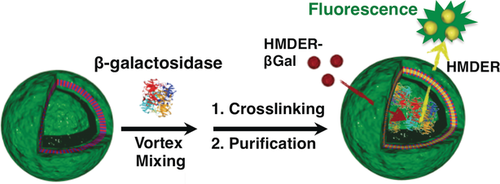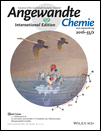Systemically Injectable Enzyme-Loaded Polyion Complex Vesicles as In Vivo Nanoreactors Functioning in Tumors
Dr. Yasutaka Anraku
Graduate School of Engineering, The University of Tokyo, 7-3-1 Hongo, Bunkyo-ku, Tokyo, 113–8656 Japan
Search for more papers by this authorCorresponding Author
Dr. Akihiro Kishimura
Faculty of Engineering, Center for Molecular Systems (CMS), Kyushu University, 744, Moto-oka, Nishi-ku, Fukuoka, 819-0395 Japan
Search for more papers by this authorDr. Mako Kamiya
Graduate School of Medicine, The University of Tokyo, 7-3-1 Hongo, Bunkyo-ku, Tokyo, 113-0033 Japan
Search for more papers by this authorDr. Sayaka Tanaka
Graduate School of Medicine, Dentistry, and Pharmaceutical Science, Okayama University, 1-1-1 Tsushima-naka, Kita-ku, Okayama, 700–8530 Japan
Search for more papers by this authorDr. Takahiro Nomoto
Polymer Chemistry Division, Chemical Resources Laboratory, Tokyo Institute of Technology, 4259 Nagatsuta, Midori-ku, Yokohama, 226–8503 Japan
Search for more papers by this authorDr. Kazuko Toh
Division of Clinical Biotechnology, Center for Disease Biology and Integrative Medicine, The University of Tokyo, Hongo 7-3-1, Bunkyo-ku, Tokyo, 113-0033 Japan
Search for more papers by this authorDr. Yu Matsumoto
Division of Clinical Biotechnology, Center for Disease Biology and Integrative Medicine, The University of Tokyo, Hongo 7-3-1, Bunkyo-ku, Tokyo, 113-0033 Japan
Search for more papers by this authorShigeto Fukushima
Graduate School of Engineering, The University of Tokyo, 7-3-1 Hongo, Bunkyo-ku, Tokyo, 113–8656 Japan
Search for more papers by this authorDaiki Sueyoshi
Graduate School of Engineering, The University of Tokyo, 7-3-1 Hongo, Bunkyo-ku, Tokyo, 113–8656 Japan
Search for more papers by this authorProf. Mitsunobu R. Kano
Graduate School of Medicine, Dentistry, and Pharmaceutical Science, Okayama University, 1-1-1 Tsushima-naka, Kita-ku, Okayama, 700–8530 Japan
Search for more papers by this authorProf. Yasuteru Urano
Graduate School of Medicine, The University of Tokyo, 7-3-1 Hongo, Bunkyo-ku, Tokyo, 113-0033 Japan
Search for more papers by this authorProf. Nobuhiro Nishiyama
Polymer Chemistry Division, Chemical Resources Laboratory, Tokyo Institute of Technology, 4259 Nagatsuta, Midori-ku, Yokohama, 226–8503 Japan
Search for more papers by this authorCorresponding Author
Prof. Kazunori Kataoka
Graduate School of Engineering, The University of Tokyo, 7-3-1 Hongo, Bunkyo-ku, Tokyo, 113–8656 Japan
Division of Clinical Biotechnology, Center for Disease Biology and Integrative Medicine, The University of Tokyo, Hongo 7-3-1, Bunkyo-ku, Tokyo, 113-0033 Japan
Search for more papers by this authorDr. Yasutaka Anraku
Graduate School of Engineering, The University of Tokyo, 7-3-1 Hongo, Bunkyo-ku, Tokyo, 113–8656 Japan
Search for more papers by this authorCorresponding Author
Dr. Akihiro Kishimura
Faculty of Engineering, Center for Molecular Systems (CMS), Kyushu University, 744, Moto-oka, Nishi-ku, Fukuoka, 819-0395 Japan
Search for more papers by this authorDr. Mako Kamiya
Graduate School of Medicine, The University of Tokyo, 7-3-1 Hongo, Bunkyo-ku, Tokyo, 113-0033 Japan
Search for more papers by this authorDr. Sayaka Tanaka
Graduate School of Medicine, Dentistry, and Pharmaceutical Science, Okayama University, 1-1-1 Tsushima-naka, Kita-ku, Okayama, 700–8530 Japan
Search for more papers by this authorDr. Takahiro Nomoto
Polymer Chemistry Division, Chemical Resources Laboratory, Tokyo Institute of Technology, 4259 Nagatsuta, Midori-ku, Yokohama, 226–8503 Japan
Search for more papers by this authorDr. Kazuko Toh
Division of Clinical Biotechnology, Center for Disease Biology and Integrative Medicine, The University of Tokyo, Hongo 7-3-1, Bunkyo-ku, Tokyo, 113-0033 Japan
Search for more papers by this authorDr. Yu Matsumoto
Division of Clinical Biotechnology, Center for Disease Biology and Integrative Medicine, The University of Tokyo, Hongo 7-3-1, Bunkyo-ku, Tokyo, 113-0033 Japan
Search for more papers by this authorShigeto Fukushima
Graduate School of Engineering, The University of Tokyo, 7-3-1 Hongo, Bunkyo-ku, Tokyo, 113–8656 Japan
Search for more papers by this authorDaiki Sueyoshi
Graduate School of Engineering, The University of Tokyo, 7-3-1 Hongo, Bunkyo-ku, Tokyo, 113–8656 Japan
Search for more papers by this authorProf. Mitsunobu R. Kano
Graduate School of Medicine, Dentistry, and Pharmaceutical Science, Okayama University, 1-1-1 Tsushima-naka, Kita-ku, Okayama, 700–8530 Japan
Search for more papers by this authorProf. Yasuteru Urano
Graduate School of Medicine, The University of Tokyo, 7-3-1 Hongo, Bunkyo-ku, Tokyo, 113-0033 Japan
Search for more papers by this authorProf. Nobuhiro Nishiyama
Polymer Chemistry Division, Chemical Resources Laboratory, Tokyo Institute of Technology, 4259 Nagatsuta, Midori-ku, Yokohama, 226–8503 Japan
Search for more papers by this authorCorresponding Author
Prof. Kazunori Kataoka
Graduate School of Engineering, The University of Tokyo, 7-3-1 Hongo, Bunkyo-ku, Tokyo, 113–8656 Japan
Division of Clinical Biotechnology, Center for Disease Biology and Integrative Medicine, The University of Tokyo, Hongo 7-3-1, Bunkyo-ku, Tokyo, 113-0033 Japan
Search for more papers by this authorGraphical Abstract
Fragile cargo: By vortex mixing, polyion complex vesicles (PICsomes) were readily loaded with enzymes, which were then delivered to tumor tissue without loss of enzyme activity. Importantly for future therapeutic applications as well as tumor imaging, the enzyme-loaded PICsomes could be used to convert a model prodrug into a highly fluorescent product at the tumor site (see picture).
Abstract
The design and construction of nanoreactors are important for biomedical applications of enzymes, but lipid- and polymeric-vesicle-based nanoreactors have some practical limitations. We have succeeded in preparing enzyme-loaded polyion complex vesicles (PICsomes) through a facile protein-loading method. The preservation of enzyme activity was confirmed even after cross-linking of the PICsomes. The cross-linked β-galactosidase-loaded PICsomes (β-gal@PICsomes) selectively accumulated in the tumor tissue of mice. Moreover, a model prodrug, HMDER-βGal, was successfully converted into a highly fluorescent product, HMDER, at the tumor site, even 4 days after administration of the β-gal@PICsomes. Intravital confocal microscopy showed continuous production of HMDER and its distribution throughout the tumor tissues. Thus, enzyme-loaded PICsomes are useful for prodrug activation at the tumor site and could be a versatile platform for enzyme delivery in enzyme prodrug therapy.
Supporting Information
As a service to our authors and readers, this journal provides supporting information supplied by the authors. Such materials are peer reviewed and may be re-organized for online delivery, but are not copy-edited or typeset. Technical support issues arising from supporting information (other than missing files) should be addressed to the authors.
| Filename | Description |
|---|---|
| anie201508339-sup-0001-misc_information.pdf966.5 KB | Supplementary |
Please note: The publisher is not responsible for the content or functionality of any supporting information supplied by the authors. Any queries (other than missing content) should be directed to the corresponding author for the article.
References
- 1J. Cui, P. van Koeverden, M. Müllner, K. Kempe, F. Caruso, Adv. Colloid Interface Sci. 2014, 207, 14–31.
- 2D. M. Vriezema, M. C. Aragone, J. A. A. W. Elemans, J. J. L. M. Cornelissen, A. E. Rowan, R. J. M. Nolte, Chem. Rev. 2005, 105, 1445–1489.
- 3P. B. Zetterlund, Polym. Chem. 2011, 2, 534–549.
- 4Q. Chen, H. Schönherr, G. J. Vancso, Small 2009, 5, 1436–1445.
- 5A. Ranquin, W. Versées, W. Meier, J. Steyaert, P. van Gelder, Nano Lett. 2005, 5, 2220–2224.
- 6P. Broz, S. Driamov, J. Ziegler, N. Ben-Haim, S. Marsch, W. Meier, P. Hunziker, Nano Lett. 2006, 6, 2349–2353.
- 7G. Delaittre, I. C. Reynhout, J. J. L. M. Cornelissen, R. J. M. Nolte, Chem. Eur. J. 2009, 15, 12600–12603.
- 8S. F. M. van Dongen, M. Nallani, J. J. L. M. Cornelissen, R. J. M. Nolte, J. C. M. van Hest, Chem. Eur. J. 2009, 15, 1107–1114.
- 9Y.-D. Lee, C.-K. Lim, A. Singh, K. Koh, J. Kim, I. K. Kwon, S. Kim, ACS Nano 2012, 6, 6759–6766.
- 10Y. Liu, J. Du, M. Yan, M. Y. Lau, J. Hu, H. Han, O. O. Yang, S. Liang, W. Wei, H. Wang, J. Li, X. Zhu, L. Shi, W. Chen, C. Ji, Y. Lu, Nat. Nanotechnol. 2013, 8, 187–192.
- 11I. Louzao, J. C. M. V. Hest, Biomacromolecules 2013, 14, 2364–2372.
- 12J. Gaitzsch, D. Appelhans, L. Wang, G. Battaglia, B. Voit, Angew. Chem. Int. Ed. 2012, 51, 4448–4451; Angew. Chem. 2012, 124, 4524–4527.
- 13M. Spulber, A. Najer, K. Winkelbach, O. Glaied, M. Waser, U. Pieles, W. Meier, N. Bruns, J. Am. Chem. Soc. 2013, 135, 9204–9212.
- 14X. Wang, G. Liu, J. Hu, G. Zhang, S. Liu, Angew. Chem. Int. Ed. 2014, 53, 3138–3142; Angew. Chem. 2014, 126, 3202–3206.
- 15T. M. Allen, P. M. Cullis, Adv. Drug Delivery Rev. 2013, 65, 36–48.
- 16P. V. Pawar, S. V. Gohil, J. P. Jain, N. Kumar, Polym. Chem. 2013, 4, 3160–3176.
- 17M. Ye, S. Kim, K. Park, J. Controlled Release 2010, 146, 241–260.
- 18A. Koide, A. Kishimura, K. Osada, W.-D. Jang, Y. Yamasaki, K. Kataoka, J. Am. Chem. Soc. 2006, 128, 5988–5989.
- 19Y. Anraku, A. Kishimura, M. Oba, Y. Yamasaki, K. Kataoka, J. Am. Chem. Soc. 2010, 132, 1631–1636.
- 20S. Chuanoi, Y. Anraku, M. Hori, A. Kishimura, K. Kataoka, Biomacromolecules 2014, 15, 2389–2397.
- 21Y. Anraku, A. Kishimura, A. Kobayashi, M. Oba, K. Kataoka, Chem. Commun. 2011, 47, 6054–6056.
- 22D. Kokuryo, Y. Anraku, A. Kishimura, S. Tanaka, M. R. Kano, J. Kershaw, N. Nishiyama, T. Saga, I. Aoki, K. Kataoka, J. Controlled Release 2013, 169, 220–227.
- 23Y. Anraku, A. Kishimura, Y. Yamasaki, K. Kataoka, J. Am. Chem. Soc. 2013, 135, 1423–1429.
- 24R. Rigler, Ü. Mets, J. Widengren, P. Kask, Eur. Biophys. J. 1993, 22, 169–175.
- 25P. Rigler, W. Meier, J. Am. Chem. Soc. 2006, 128, 367–373.
- 26M. Kamiya, D. Asanuma, E. Kuranaga, A. Takeishi, M. Sakabe, T. Nagano, Y. Urano, J. Am. Chem. Soc. 2011, 133, 12960–12963.
- 27J.-P. Tenu, O. M. Viratelle, J. Garnier, J. Yon, Eur. J. Biochem. 1971, 20, 363–370.
- 28Y. Matsumoto, T. Nomoto, H. Cabral, Y. Matsumoto, S. Watanabe, R. J. Christie, K. Miyata, M. Oba, T. Ogura, Y. Yamasaki, N. Nishiyama, T. Yamasoba, K. Kataoka, Biomed. Opt. Express 2010, 1, 1209–1216.
- 29H. Cabral, Y. Matsumoto, K. Mizuno, Q. Chen, M. Murakami, M. Kimura, Y. Terada, M. R. Kano, K. Miyazono, M. Uesaka, N. Nishiyama, K. Kataoka, Nat. Nanotechnol. 2011, 6, 815–823.
- 30H.-J. Kim, M. Oba, F. Pittella, T. Nomoto, H. Cabral, Y. Matsumoto, K. Miyata, N. Nishiyama, K. Kataoka, J. Drug Targeting 2012, 20, 33–42.
- 31H. A. Campbell, L. T. Mashburn, E. A. Boyse, L. J. Old, Biochemistry 1967, 6, 721–730.
- 32C. S. Fishburn, J. Pharm. Sci. 2008, 97, 4167–4183.
- 33J. Rautio, H. Kumpulainen, T. Heimbach, R. Oliyai, D. Oh, T. Järvinen, J. Savolaonen, Nat. Rev. Drug Discovery 2008, 7, 255–270.
- 34D. Niculescu-Duvaz, G. Negoita-Giras, I. Niculescu-Duvaz, D. Hedley, C. J. Springer in Prodrugs and Targeted Delivery (Ed.: ), Wiley-VCH, Weinheim, 2011, pp. 271–344.
10.1002/9783527633166.ch12 Google Scholar





